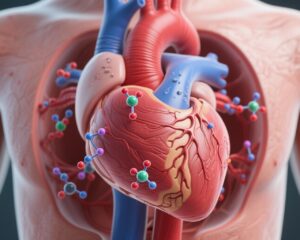Highlight
- Aficamten monotherapy significantly improves peak oxygen uptake compared to metoprolol in obstructive HCM patients at 24 weeks.
- Greater symptomatic relief and hemodynamic improvement were observed with aficamten, including reductions in outflow tract gradients and biomarkers.
- Adverse event rates were comparable between aficamten and metoprolol treatment groups.
- The trial supports aficamten as a promising targeted therapy for symptomatic obstructive HCM, with potential to shift treatment paradigm from beta-blockers.
Study Background and Disease Burden
Obstructive hypertrophic cardiomyopathy (HCM) is a genetically mediated myocardial disease characterized by asymmetric left ventricular hypertrophy and dynamic left ventricular outflow tract (LVOT) obstruction. This condition manifests clinically with symptoms including exertional dyspnea, chest pain, and syncope, significantly impairing quality of life and increasing risk for adverse cardiovascular events. Beta-blockers have long been the cornerstone for symptomatic management, aiming to reduce myocardial contractility and heart rate to alleviate obstruction. However, despite widespread use, robust evidence supporting their efficacy on functional capacity and hemodynamic parameters remains limited.
Cardiac myosin inhibitors have emerged as a novel therapeutic class targeting the fundamental pathophysiology of HCM: hypercontractility driven by myosin-actin interactions. Aficamten is a second-generation cardiac myosin inhibitor shown in prior studies to reduce LVOT gradients, improve exercise capacity, and decrease symptoms when added to standard care. Yet, the direct comparison of aficamten monotherapy against traditional beta-blocker monotherapy had remained unknown, representing a critical knowledge gap in optimizing frontline treatment for obstructive HCM.
Study Design
The MAPLE-HCM trial was an international, randomized, double-blind, double-dummy phase 3 study assessing aficamten versus metoprolol monotherapy in adults with symptomatic obstructive HCM. 175 patients (mean age 58 years, 58.3% male) with LVOT gradient ≥30 mm Hg at rest or ≥50 mm Hg with Valsalva and New York Heart Association (NYHA) functional class II or III symptoms were evenly randomized to receive either aficamten (5 to 20 mg daily) plus placebo or metoprolol (50 to 200 mg daily) plus placebo. Dosing adjustments were guided by clinical response.
The primary endpoint was change in peak oxygen uptake (VO2 peak) from baseline to week 24, an objective measure of exercise capacity correlated with clinical status and prognosis. Secondary endpoints included changes in NYHA functional class, Kansas City Cardiomyopathy Questionnaire clinical summary score (KCCQ-CSS), LVOT gradient after Valsalva, N-terminal pro-B-type natriuretic peptide (NT-proBNP) levels, left atrial volume index, and left ventricular mass index.
Key Findings
At 24 weeks, patients treated with aficamten exhibited a mean increase in peak oxygen uptake of 1.1 ml/kg/min (95% CI, 0.5 to 1.7), whereas the metoprolol group experienced a decrease of 1.2 ml/kg/min (95% CI, –1.7 to –0.8), yielding a statistically significant between-group difference of 2.3 ml/kg/min (95% CI, 1.5 to 3.1; P<0.001).
Symptomatically, the aficamten cohort showed greater NYHA functional class improvements, with a higher proportion of patients achieving class I symptoms compared to metoprolol. The KCCQ-CSS, a validated patient-reported outcome metric reflecting clinical status and quality of life, improved significantly more with aficamten.
Hemodynamic assessments demonstrated significant reductions in LVOT gradients after Valsalva maneuver in the aficamten group, accompanied by decreases in NT-proBNP levels—a biomarker indicative of myocardial stress—and left atrial volume index, suggesting amelioration of cardiac filling pressures and remodeling. Left ventricular mass index did not differ significantly between groups at 24 weeks.
Importantly, the safety profile was similar between both treatments. Adverse events were generally mild to moderate and occurred with comparable frequency, indicating that aficamten’s benefits are not offset by increased risk.
Expert Commentary
The MAPLE-HCM trial is a landmark in obstructive HCM management, furnishing high-quality evidence that aficamten monotherapy surpasses traditional beta-blocker therapy in enhancing objective exercise capacity and symptom burden. This supports the pathophysiologic rationale of directly targeting myosin hypercontractility rather than merely modulating heart rate and contractility indirectly.
While beta-blockers remain widely used due to their accessibility, affordability, and empirical experience, their limitations in modifying the disease’s intrinsic mechanics have been apparent. Aficamten’s capacity to reduce LVOT obstruction aligns with improved clinical parameters and elevated patient-reported outcomes, favorably impacting quality of life.
Limitations of the study include the relatively short duration of 24 weeks, which precludes conclusions about long-term efficacy and impact on hard cardiovascular outcomes such as heart failure progression or arrhythmic risk. Furthermore, the trial population, though international, was moderate in size, and future real-world data will be crucial to validate generalizability across diverse clinical settings.
Mechanistically, cardiac myosin inhibitors like aficamten mitigate the excessive actin-myosin cross-bridge formation underlying hypercontractility, thereby alleviating obstruction without negative chronotropic effects that can limit exercise tolerance. This unique profile may explain the paradoxical decline in peak VO2 observed with metoprolol despite symptom relief in some.
Conclusion
Aficamten monotherapy provides significant superiority over metoprolol monotherapy in treating symptomatic obstructive hypertrophic cardiomyopathy by improving exercise capacity, reducing LVOT gradients, and enhancing patient-reported symptom burden without added safety concerns. These findings herald a paradigm shift in first-line pharmacologic treatment of obstructive HCM, favoring precision-targeted cardiac myosin inhibition.
Longer-term studies assessing clinical event reduction and combination therapy strategies are warranted. Nevertheless, aficamten emerges as a promising agent that may redefine therapeutic standards for patients with symptomatic obstructive HCM, addressing an unmet need with evidence-based innovation.
References
Garcia-Pavia P, Maron MS, Masri A, et al; MAPLE-HCM Investigators. Aficamten or Metoprolol Monotherapy for Obstructive Hypertrophic Cardiomyopathy. N Engl J Med. 2025 Sep 11;393(10):949-960. doi:10.1056/NEJMoa2504654. Epub 2025 Aug 30. PMID: 40888697.
Olivotto I, Oreziak A, Barriales-Villa R, et al. Mavacamten for Treatment of Symptomatic Obstructive Hypertrophic Cardiomyopathy (EXPLORER-HCM): a Randomised, Double-Blind, Placebo-Controlled, Phase 3 Trial. Lancet. 2020 Feb 8;395(10242):200-211. doi:10.1016/S0140-6736(19)33044-0.
Maron BJ, Maron MS, Semsarian C. Prevention of Sudden Death in Hypertrophic Cardiomyopathy: Am J Cardiol. 2021;148:35-42.
# Visual Thumbnail Prompt
“Illustration of left ventricular outflow tract obstruction showing a dynamic gradient, alongside a molecular graphic depicting cardiac myosin inhibition by aficamten, with a background of a patient performing exercise testing”




